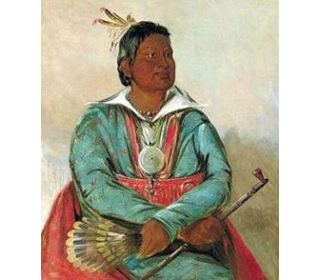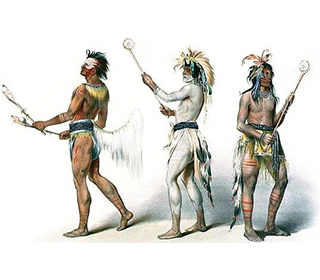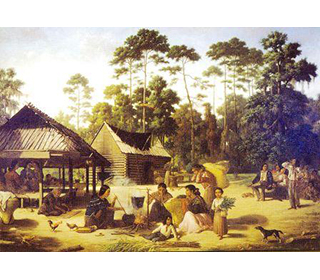Picture of the Choctaw Native Indian
The above picture depicts Mushulatubbee, meaning "Determined to Kill" who was a Chief of the Choctaw. It was painted by the famous artist George Catlin (1796-1872) in 1838. The chief wore European-style clothing, as worn by many of the southeastern tribes with a decorative sash around his waist. Mushulatubbee led his warriors to assist General Andrew Jackson in the Creek War, also known as the Red Stick War (1813–1814). What was the lifestyle and culture of the Choctaw tribe?
The Choctaw tribe are descendants of the people of the Mississippian culture, who built earthwork mounds at their villages located throughout the Mississippi River valley (refer to the Natchez Tribe for more facts). The Creek people established villages across the Deep South and used dugout canoes to travel and trade with many other tribes. Their numbers diminished due to the diseases brought by the Europeans including the Spanish, French and British. They allied with both the French and Americans against the British. Following the War of Independence the 'civilizing programs' began. The Choctaw fought under Andrew Jackson in the Creek War (1813–1814). Many Creeks adopted European practises such as European style dress, housing and farming techniques but despite this and their loyalty to the Americans they were sent to reservations. The Choctaw tribe became known as one of the Five Civilised Tribes who also included the Cherokee, Creek, Chickasaw and Seminoles tribes. Where did the Choctaw tribe live?
The Choctaw are people of the Southeast Native American cultural group. The geography of the region in which they lived dictated the lifestyle and culture of the Choctaw tribe. - The Southeast region extended mainly across the states of Louisiana, Tennessee, Alabama, Georgia and Florida
- Land: River Valleys, mountains and swamps
- Climate: The climate was hot and humid in the summer and mild in the winter
- Animals: The animals included rabbit, wild hog, turkey, opossum, raccoon, squirrel and deer
- Crops: The crops grown in the area were corn, beans, squash, melons and sunflowers
- Natural resources: Fruit, seeds and nuts
Choctaw played Stickball
The Choctaw played stickball (called kabucha in Choctaw), the forerunner of lacrosse. The picture by George Catlin depicts Sioux and Choctaw stickball players. One team painted themselves white to distinguish them from the other team. As many as 100 - 1,000 men from opposing tribes or villages would participate in these games. The ball was caught with a netted ball-stick. |


